
In today's summary:
- Yevgeny Prigozhin, Russia’s Ministry of Defense, and the Kremlin all claimed the capture of Bakhmut;
- Ukrainian officials insist that the battle for the city continues;
- Russia’s “war correspondents” have called the fall of Bakhmut, a small town in the Donetsk region, a “feat of Russian arms”;
- With the capture of Bakhmut, the winter and spring offensive campaign of Russian forces is apparently complete;
- A Ukrainian sabotage group has entered Russia’s Belgorod region, where 10 billion roubles ($125 million) were spent to fortify the border;
- A tactical nuclear ammunition storage facility has been confirmed as located near the battlefields in the Belgorod region;
- The US announced a new $375 million military aid package for Ukraine;
- Ukrainian pilots have begun training on Western F-16 fighter jets.
The front line
One of the founders and chief public spokesman of the Wagner Private Military Company (PMC), Yevgeny Prigozhin, announced the final capture of Bakhmut on May 20. The entire operation took 224 days (since October 8, 2022), according to his calculations. Prigozhin thanked generals Sergei Surovikin (commander-in-chief of the Air Force and deputy commander of the Russian grouping in Ukraine) and Mikhail Mizintsev (former deputy defense minister for logistics), as well as President Vladimir Putin, adding that he had fought not only the Ukrainian army, but also “near-war bureaucrats” such as Defense Minister Sergei Shoigu and Chief of General Staff Valery Gerasimov, the Commander of Russia’s forces in Ukraine.
Prigozhin added that the Defense Ministry's “methodology of operational-tactical calculations” indicated that the Wagner PMC “should have been 23 times larger in [troop] number, the number of weapons should have been 27 times larger, and [the group] received only 11.5% [of the required] shells.”
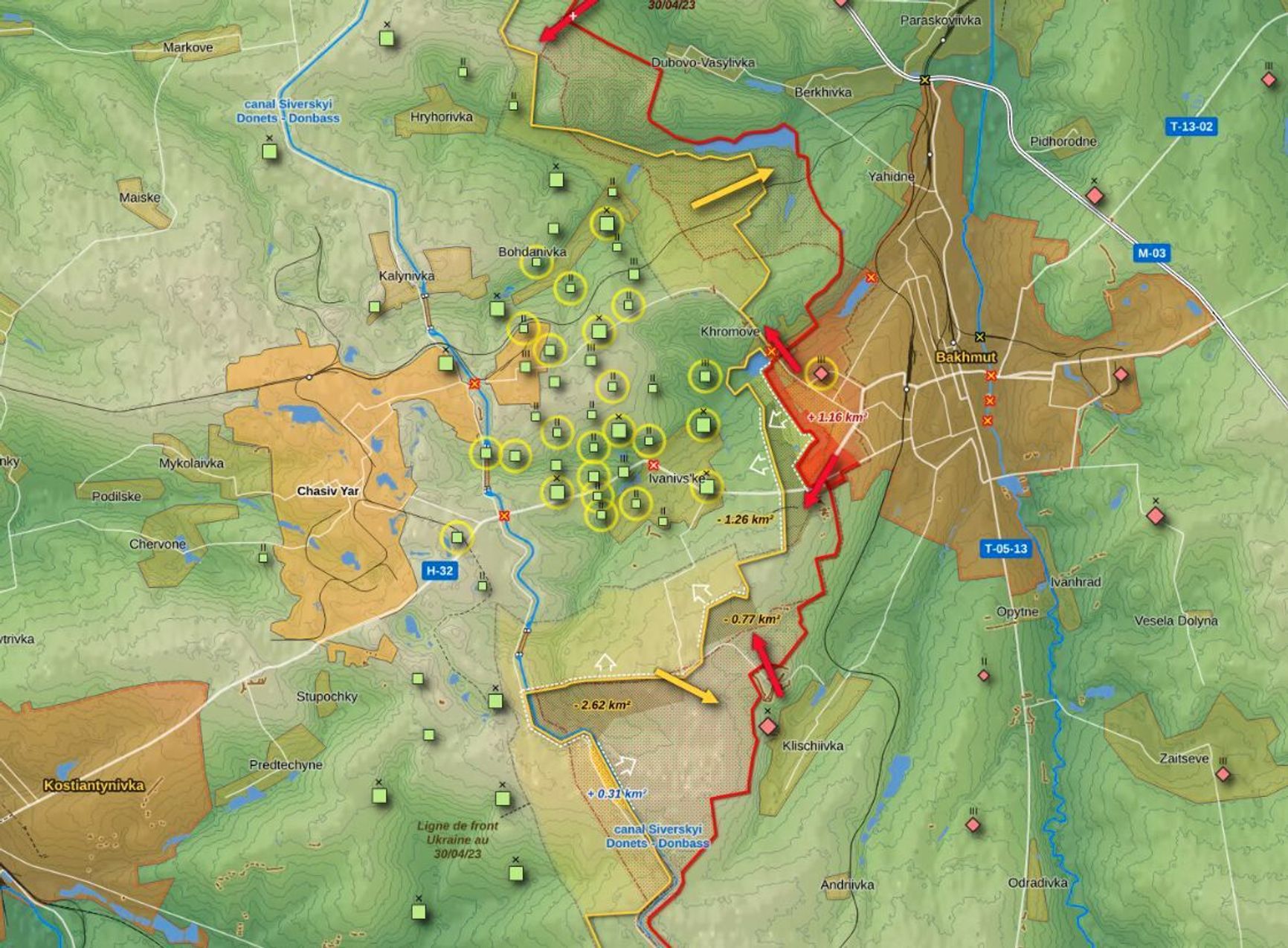
On the night of May 21, Russian state news agencies circulated a congratulatory message from President Vladimir Putin on the “completion of the operation to liberate Artemovsk [Bakhmut – The Insider].” The Kremlin's official website later posted a separate message, dated 1 a.m. on May 21.
In the morning, the Russian Ministry of Defense announced in an official summary:
“The liberation of the town of Artemovsk [Bakhmut] in the Artemovsk [Bakhmut] tactical direction as a result of offensive actions by Wagner assault detachments supported by artillery and aviation of the ‘Southern’ group of troops was completed.”
Prigozhin issued a separate comment on the Defense Ministry's statement, noting that during the seven months of storming Bakhmut, strategic aviation indeed assisted the group “several times” with long-range missile strikes, and assigned the 305th Artillery Brigade to the PMC’s command, along with the the 57th Separate Guards Motorized Rifle Brigade. According to Prigozhin, reports of Russia’s airborne troops taking part in the capture of Bakhmut are “complete nonsense.” He also criticized the 55th “Tuva” brigade (the 55th Mountain Motor Rifle Brigade), which was allegedly “generously rewarded” with decorations and honors.
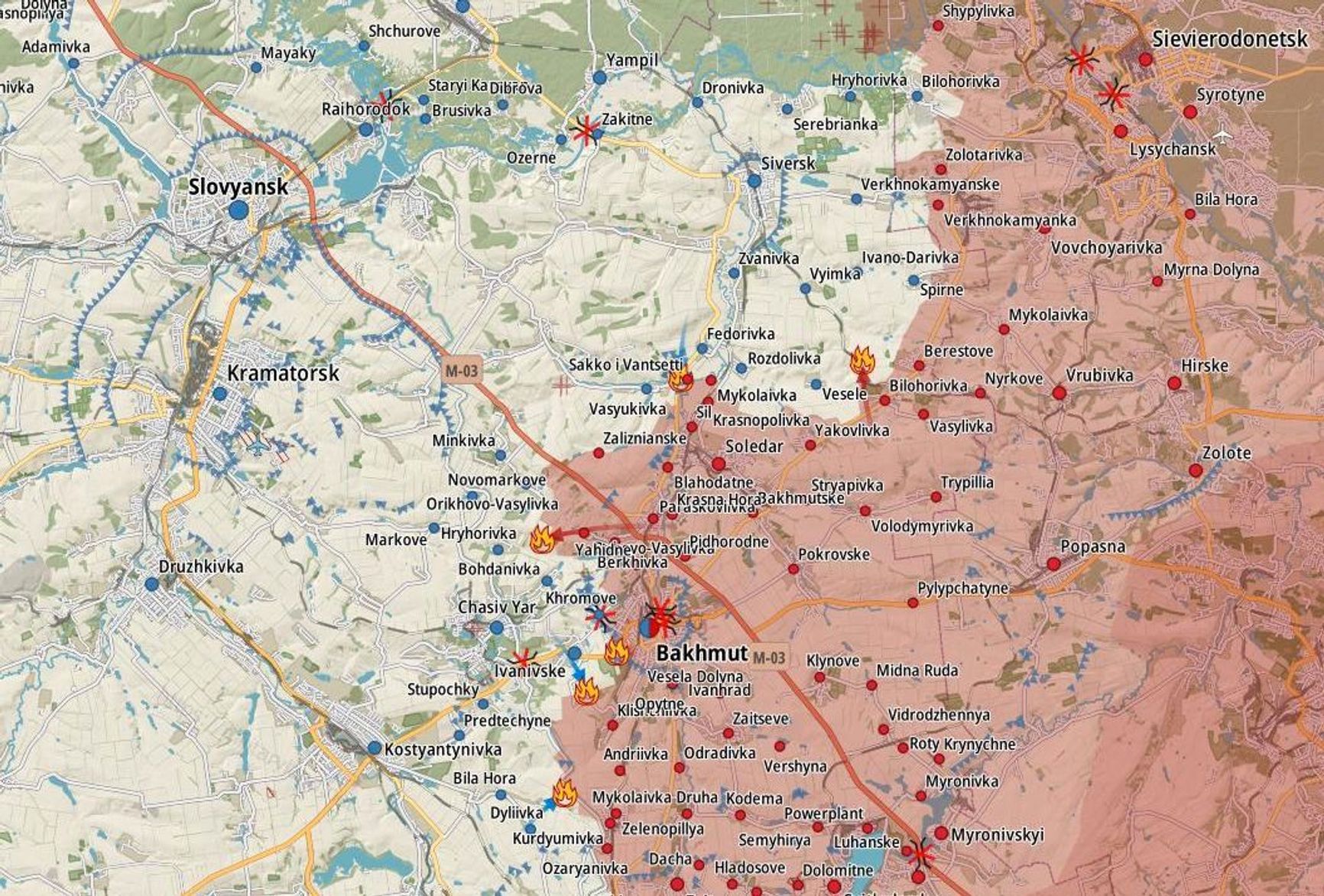
Reports of the formal capture of Bakhmut caused incredible euphoria in the pro-Russian media field.
Alexander Sladkov, a “military correspondent” for state-run channel VGTRK, wrote a column for RT in which (as far as one can tell, quite seriously) he called the capture of the city “a triumph” – “a triumph of Soviet strategy successfully developed in a completely free, active way, without conservative military blinders” and at the same time “a crude, forceful 'downfall' of the NATO combat strategy and tactics imposed on Ukrainians by their Western masters.” According to Sladkov, the capture of the city was “proof that the Russian fighting spirit is stronger than the Ukrainian and Western (mercenaries) fighting spirit.”
Sladkov also feared that the “triumph” in Bakhmut “will sink into oblivion”, leading him to suggest the following:
- Record detailed interviews of the commanders and fighters of the Wagner PMC and the participating servicemen from the Ministry of Defense describing “How things really happened”;
- To land a working group of military (civilian) historians in Bakhmut to create a historical formulary “The Assault on Bakhmut”;
- Award the heroes of the assault loudly (not in a closet), and name streets in their homeland after them;
- To control the competent and objective filling out of the combat action forms (as it is supposed to be);
- Collect everything of value to create a museum of Bakhmut's liberation (trophies, commanders' maps, etc.);
- Urgently send a landing party of photographers and cameramen in Bakhmut, who, within a week, taking their time, using light and equipment, will capture everything that the accompanying fighters show them;
Another VGTRK “war correspondent,” Yevgeny Poddubny, wrote of “Victory” in the “battle for Bakhmut” on his Telegram channel.
“The Battle for Bakhmut ended with our Victory. A low bow to all the guys from ‘Wagner.’ Thank you for this Victory. God rest the dead heroes.”
Alexander Simonov, a “military correspondent” with ties to the Wagner PMC, wrote of “a feat of Russian arms, which should go into the military history textbooks.”
“This is a real feat of Russian arms, which should be included in the textbooks on military history of our state.
The guys went in for the assault in their usual calculating, but energetic and assertive manner, and outplayed the enemy in a fair fight.”
Pro-war poet Anna Dolgareva went furthest – her poem contained the line “all Wagnerites go to heaven.”
The texts are accompanied by images depicting the slogans “Bakhmut is ours” (“Bakhmut nash”) and glorifying the Wagner PMC.
Wagner mercenaries that took part in the capture of the city have received medals bearing the inscription “Bakhmut meat grinder” (“Bakhmutskaya myasorubka”) – the phrase is written on both sides of the medal, and is listed as the name of the operation. Distinguished Wagner mercenaries also received gold coins. The awards are notably internal, since the mercenaries have not been presented with Russian government decorations as of late.
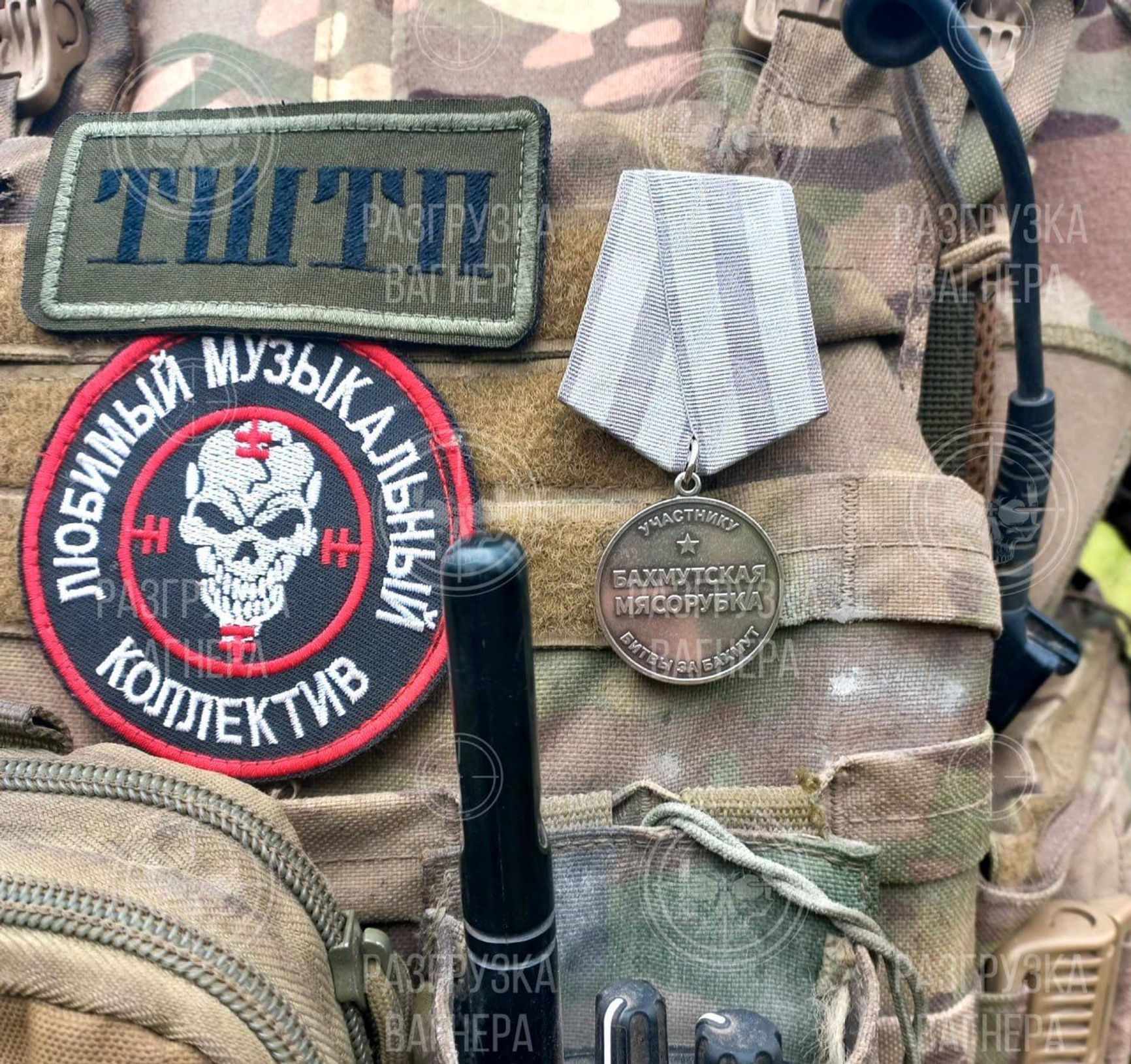
Ukraine has not yet confirmed the loss of Bakhmut. On the contrary, the commander of Ukraine’s Ground Forces, Oleksandr Syrskyi, spoke of pressure on the flanks and an approach to the “tactical encirclement” of the city. The Insider notes that this is still a long way off, however, Syrskyi may be referring to the occupation of the elevated areas around the city, which Prigozhin confirmed not long ago.
Ukrainian President Volodymyr Zelensky, responding to a reporter's question about whether Bakhmut remains in Ukrainian hands as the Russians claimed they have seized it, said: “I think no.» Reuters interpreted his words as an admission that the Armed Forces of Ukraine (AFU) had lost control of the city. However, Zelensky's press office assured Financial Times journalist Christopher Miller, who asked the question, that the president's words meant exactly the opposite, and were a response to the second part of the question that the Russians had taken Bakhmut.
A map compiled by the Ukrainian project Deep State based on geolocated objects from open sources, as of the evening of May 22, showed several buildings and the location of the famous monument to the MiG-17 aircraft still marked as disputed territories. However, the map may not fully correspond to the current situation, and there has been no actual confirmation of the presence of Ukrainian forces in the area.

The AFU’s 3rd Separate Assault Brigade, operating in the Bakhmut area reported an advance of 700 meters deep and 1,730 meters wide in an area controlled by Russia’s 72nd Separate Motorized Rifle Brigade. A brigade officer and one of the founders of the Azov regiment, Andriy Biletsky, publishes footage of prisoners of war reportedly from the “Storm Z” detachment (Russian Defense Ministry formations recruited from Russian prisoners), which was attached to the 72nd Independent Motorized Assault Brigade.
Even if Bakhmut has come under the complete control of Russian forces, in light of Prigozhin's statement about the withdrawal of Wagner PMC units to the rear for rest and retraining since May 25, the further actions of the Russian command in this direction are unclear.
If Prigozhin’s claims are to be believed, there will be no Wagner PMC mercenaries on the line of contact on June 1 – all of them will leave for regrouping, re-equipping and additional training, scheduled for two months. According to the chairman of the Joint Chiefs of Staff, General Mark Milley, the number of Wagner mercenaries storming Bakhmut in March 2023, was 6,000 people, and another 20-30 thousand were new recruits.
Even taking into account the losses, this means that the Russian command will lose at least several brigades in the Bakhmut direction, which must be promptly replaced.
It is still unclear how exactly the Wagner PMC will prepare the defensive lines in Bakhmut and organize the process of passing the city under the control of regular units of the Russian Armed Forces. ISW analysts believe that it will not work without losses. They remind us that the AFU can still conduct effective artillery shelling of the destroyed city. In such a situation, it is extremely difficult to rotate personnel, given the poor coordination between the mercenaries and Russian Defense Ministry units.
Prigozhin did not miss a chance to mock Russia Defense Minister Sergei Shoigu on his birthday. Prigozhin sent Shoigu a congratulatory letter referring to him as “the president of the Russian Geographical Society, a Knight of the Order of Malta” and describing him as a man who combines “the abilities of a refined aesthete, graphic artist, woodcarver, hunter, hockey fan, and a caring father and father-in-law.” There is not a word about the minister's military capabilities in Prigozhin's letter.
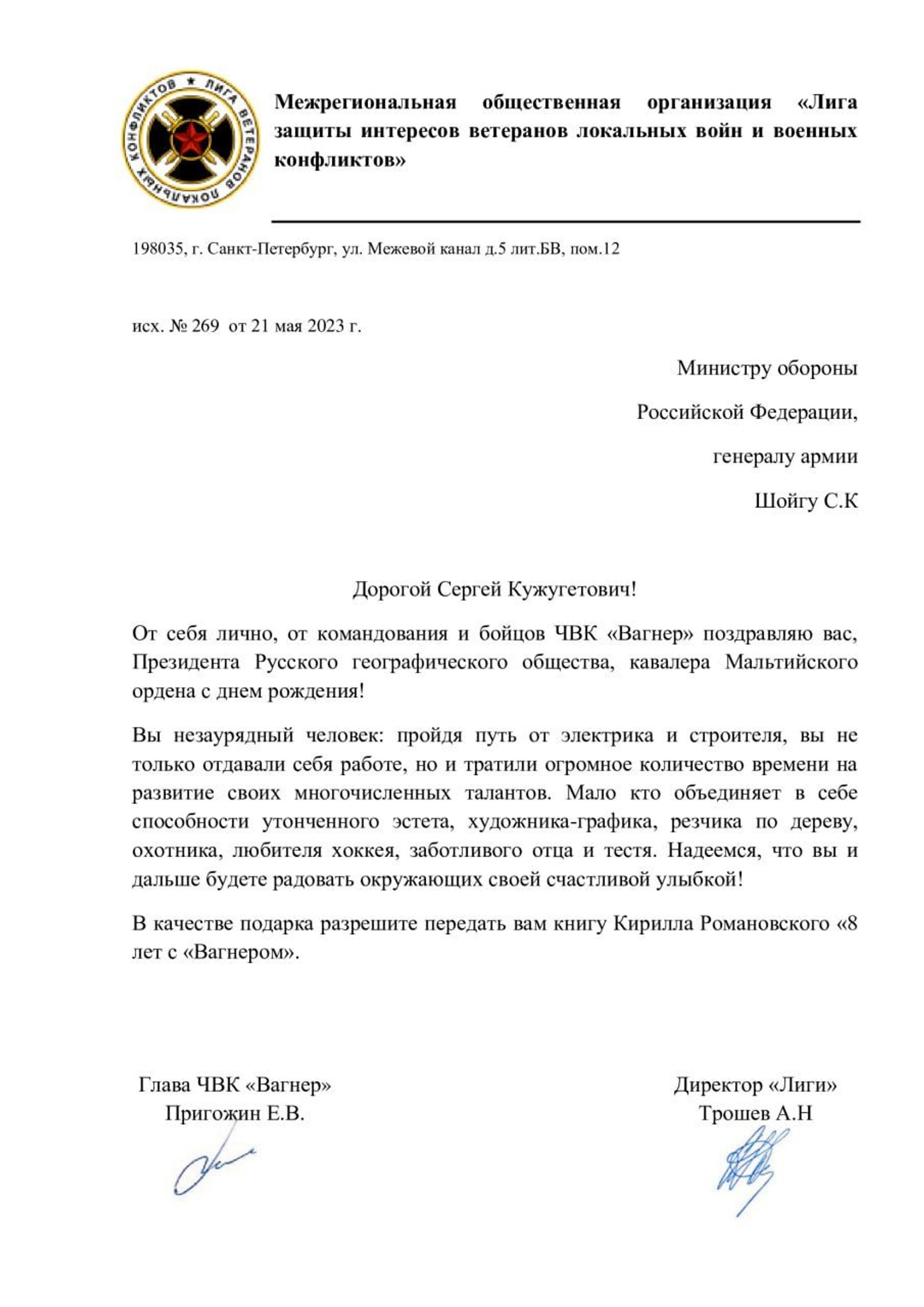
A Telegram channel close to convicted war criminal Igor Girkin (also known by the names Strelkov and Runov), one of the field commanders of the pro-Russian separatists in the Donbas in 2014, assessed capture of Bakhmut as a tactical victory at best. The channel highlighted Yevgeny Prigozhin becoming a serious political figure as the most notable result of the months-long operation.
Girkin viewed the storming of Bakhmut in the context of the Russian command's overall winter and spring campaign and concluded that it ended in “strategic failure.”
“On the whole, the operation ended in a strategic failure for our troops. The enemy was NOT pushed out of Donbas in all major directions, and in most directions it was not moved at all.
During the offensive the Russian Armed Forces used up a lot of trained manpower, depleted the stocks of weapons, equipment and ammunition necessary for further offensive operations almost entirely.»
Girkin now expects a “retaliatory move” from the AFU, as this is a particularly good time for a Ukrainian offensive – the Russian Armed Forces' best assault units are exhausted by months of fighting, and their ammunition supply is heavily depleted.
OSINT researcher Def Mon also summarized the Russian troops' winter-spring campaign.
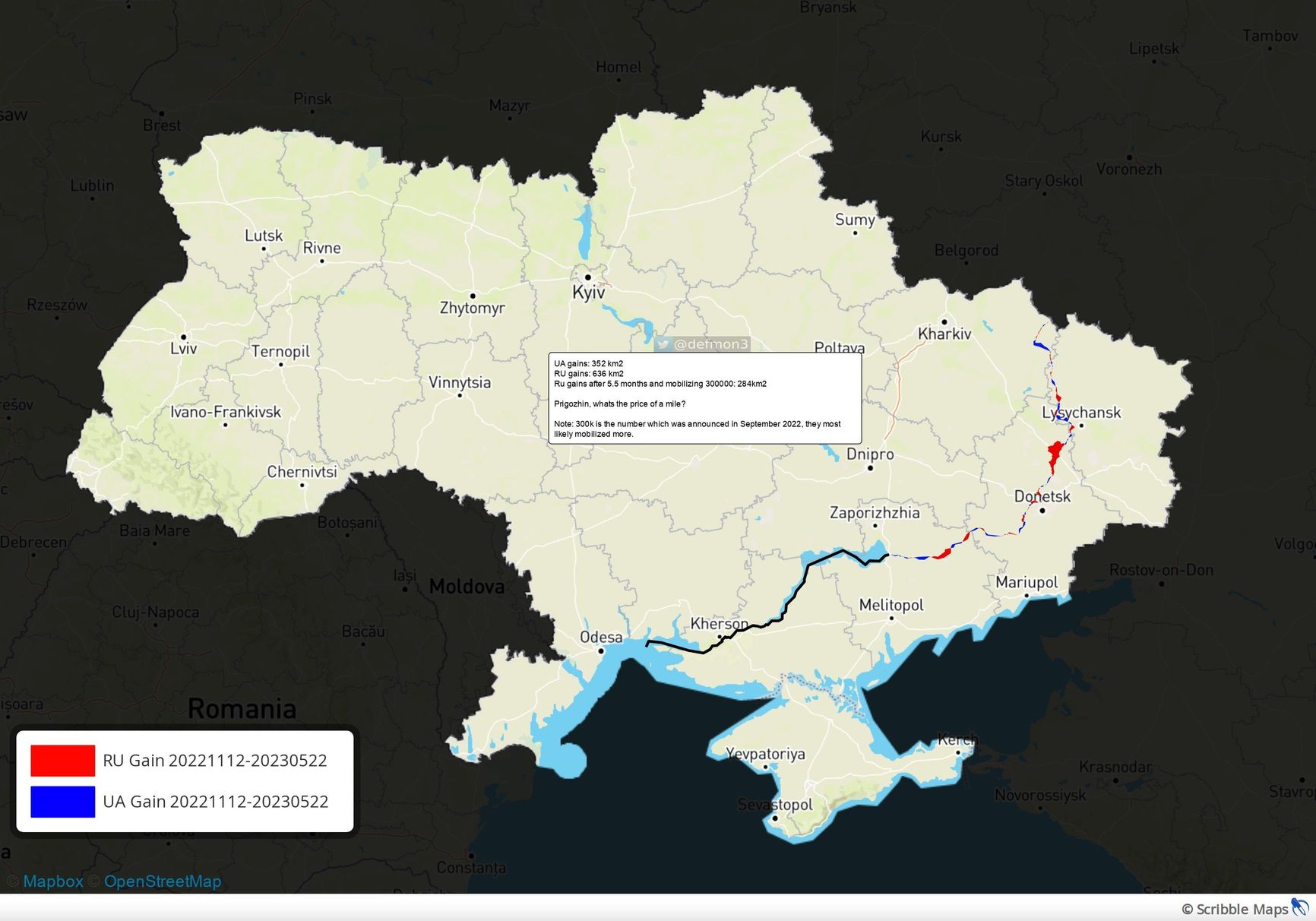
According to Def Mon, the advance of the Russian Armed Forces (highlighted in red on the map) in almost all areas of the line of contact was extremely insignificant.
Shelling and sabotage
In the past few days, the AFU expanded the range of its strikes with long-range airborne Storm Shadow missiles on Berdyansk and Mariupol. Strikes on airfields were recorded in both cities. The Telegram channel Rybar, affiliated with the Russian Defense Ministry, believes that the main objective of the missile strike campaign is to reduce the combat capabilities of the Russian Air Force. At the same time, analyst Oliver Alexander, after studying the strike on Mariupol, concluded that it may have been carried out on an underground bunker “that could well have been the target and possible site of a Russian command post” visited by Sergei Shoigu shortly before the hit.
The Telegram channel Operativny ZSU reported a strike on an airfield near the village of Mospine in the Donetsk region, likely targeted at an ammunition depot. Earlier, a Pantsir S-1 surface-to-air SAM system covering the airfield had been destroyed at the same location.
Representatives of the occupation authorities in Zaporizhzia region reported two explosions near the town of Tokmak. Russian state-run media outlet RIA Novosti reported that the city was de-energized.
The Ukrainian Air Force Command reported the destruction of 20 kamikaze drones and four cruise missiles during a Russian strike on military and civilian infrastructure in the city of Dnipro on the night of May 22. A total of four Kh-101/Kh-555 cruise missiles, five Kh-22 cruise missiles, two Iskander-M ballistic missiles, five S-300 anti-aircraft guided missiles, and 20 Iranian Shahed-type (Geran) drones were launched at the city. None of the ballistic missiles or Kh-22 missiles could be shot down, meaning that these munitions are still a problem for the Ukrainian air defense system, which has only a limited number of modern Western systems equipped to combat them.
Multiple hits were recorded during the attack on Dnipro, according to a Telegram post from the head of the Dnipro Regional Military Administration (OVA) Serhiy Lysak. Several rescue service buildings were damaged, and trucks, vehicles and other special equipment were destroyed. A 27-year-old man was injured and taken to a local hospital.
The border areas of Russia's Belgorod region have been under artillery fire for several days. On May 22, geolocated video footage of the shelling of the Grayvoron border crossing point along with the movement of an unidentified tank towards it surfaced online.
The situation began to develop rapidly. Closer to noon, Belgorod Region Governor Vyacheslav Gladkov spoke only of shelling and “information attacks,” later admitting that a “Ukrainian sabotage group” had breached the border.
Prior to Gladkov’s report, the Telegram channel of the Russian Volunteer Corps (“Rossiskiy Dobrovolchesky Korpus,” or RDK – a military formation made up of Russian citizens fighting on the side of Ukraine) published posts with photos and videos of road signs showing Russian settlements, as well as footage of the movement of military equipment.
The situation began to develop rapidly. Closer to noon, Belgorod Region Governor Vyacheslav Gladkov spoke only of shelling and “information attacks,” later admitting that a “Ukrainian sabotage group” had breached the border.
Prior to Gladkov’s report, the Telegram channel of the Russian Volunteer Corps (“Rossiskiy Dobrovolchesky Korpus,” or RDK – a military formation made up of Russian citizens fighting on the side of Ukraine) published posts with photos and videos of road signs showing Russian settlements, as well as footage of the movement of military equipment.
Ukrainian military intelligence spokesman Andriy Yusov confirmed that the RDK, together with the Russian Legion of Freedom (another unit formed from Russians fighting for Ukraine), was conducting an operation to “liberate the Belgorod region’s territories from the so-called Putin regime and push back the enemy in order to create a secure zone to protect Ukrainian civilians.”
The Telegram channel Rybar, affiliated with the Russian Defense Ministry, reported two tanks, one APC, and nine armored combat vehicles entering the Belgorod region from the Grayvoron border crossing. The channel's authors reported that the group was able to advance as far as the Kozinka-Glotovo crossing, with an infantry group reaching the House of Culture in Glotovo.
Sirens were sounded across various settlements in the region, and a message was broadcast on the radio stating that citizens should “putty their windows to make them airtight” and lock themselves in their homes. The pro-Kremlin Telegram channel SHOT reported on the “partial evacuation” of the village of Kozinka in the Belgorod region.
Later that evening, the deputy head of the Grayvoron administration was reported injured during an attack on the administration building. Two emergency services workers were also reported injured. Subsequent reports confirmed that eight people had been wounded in the region as a whole.
Russian Mi-8 and Mi-28 helicopters were seen flying low and shooting off decoy flares near the battle sites, likely to avoid a repeat of an earlier incident in the Bryansk region, where two Russian helicopters and two aircraft were shot down on the same day. Later in the day, heavy Mi-26 transport helicopters and Ka-52 attack helicopters were seen in the sky. There were also reports of armored vehicles heading in the direction of the border.
The Belgorod region's Interior Ministry put the “Edelweiss” plan into action, which involved the round-up of all law enforcement officers in the area. It is worth noting that Russian propagandists have long discussed the name of the AFU’s “Edelweiss” 10th Separate Mountain Assault Brigade, recalling the alleged existence of a Wehrmacht division with a similar name during World War II.
A Russian pro-war Telegram channel wrote that the saboteurs acted as part of an infantry battalion (an odd statement, given that there were only a dozen armored cars and APCs in the column, while a battalion usually has 200 men) with the support of a tank platoon, as well as barrel and rocket artillery. Russian pro-war channel Helicopterpilot, close to the country’s military aviation, claimed that “work” was underway in the Belgorod region, but “there will be no comments yet, it’s literally [Afghanistan] out there.”
The Russian channel Military Informant (“Voyenniy Osvedomitel”) attempted to analyze the incident, saying that after an artillery bombardment a tank made a hole in the wall of one of the checkpoint buildings, then saboteurs occupied the border checkpoint and eventually proceeded 8 kilometers deep into the Russian territory without meeting any resistance:
All in all, we successfully blew: 1) the concentration of an enemy armored group in the border area, 2) their advance by column on the road in the middle of broad daylight, 3) a break through the border point, 4) a further break into the interior.
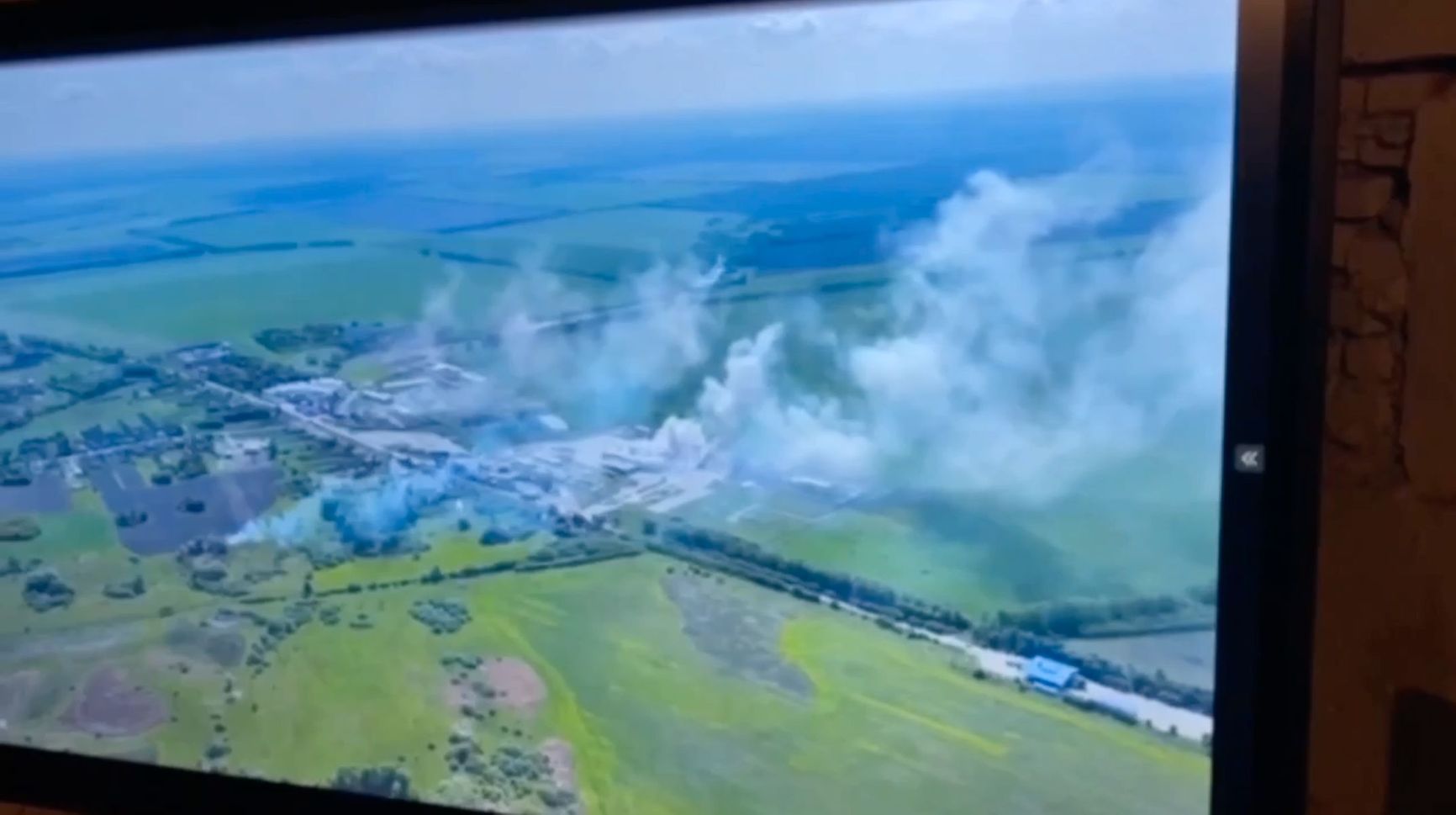
Propaganda channel RT spoke of a “trap” that the Russian military had used to lure in the saboteurs. Their plan was allegedly to allow the group to pass as far as Grayvoron, and to eliminate them there. “There were no hostages, no evacuation was announced, and the locals decided to leave on their own. The operation is under control,” an anonymous source told the propagandists. Despite the claim, there were reports of buses transporting civilians from the Grayvoron district later that day.
As recalled by the Telegram channel Grey Zone, affiliated with the Wagner PMC, the Russian authorities had spent close to 10 billion roubles ($125 million) on the fortification of the country’s border. These fortifications were proudly nicknamed with something straight out of the history books – the “Zasechnaya Cherta.” The name alludes to a chain of fortification lines created by the Grand Duchy of Moscow to protect itself from Crimean-Nogai raids that ravaged the southern provinces of the country in the 16th century. Grey Zone's creators were clearly being ironic, with the post reading:
But who could have known that they would go straight through the checkpoints. I think they even called ahead and booked a time to cross, so that everything would follow the rules and no red lines would be crossed.
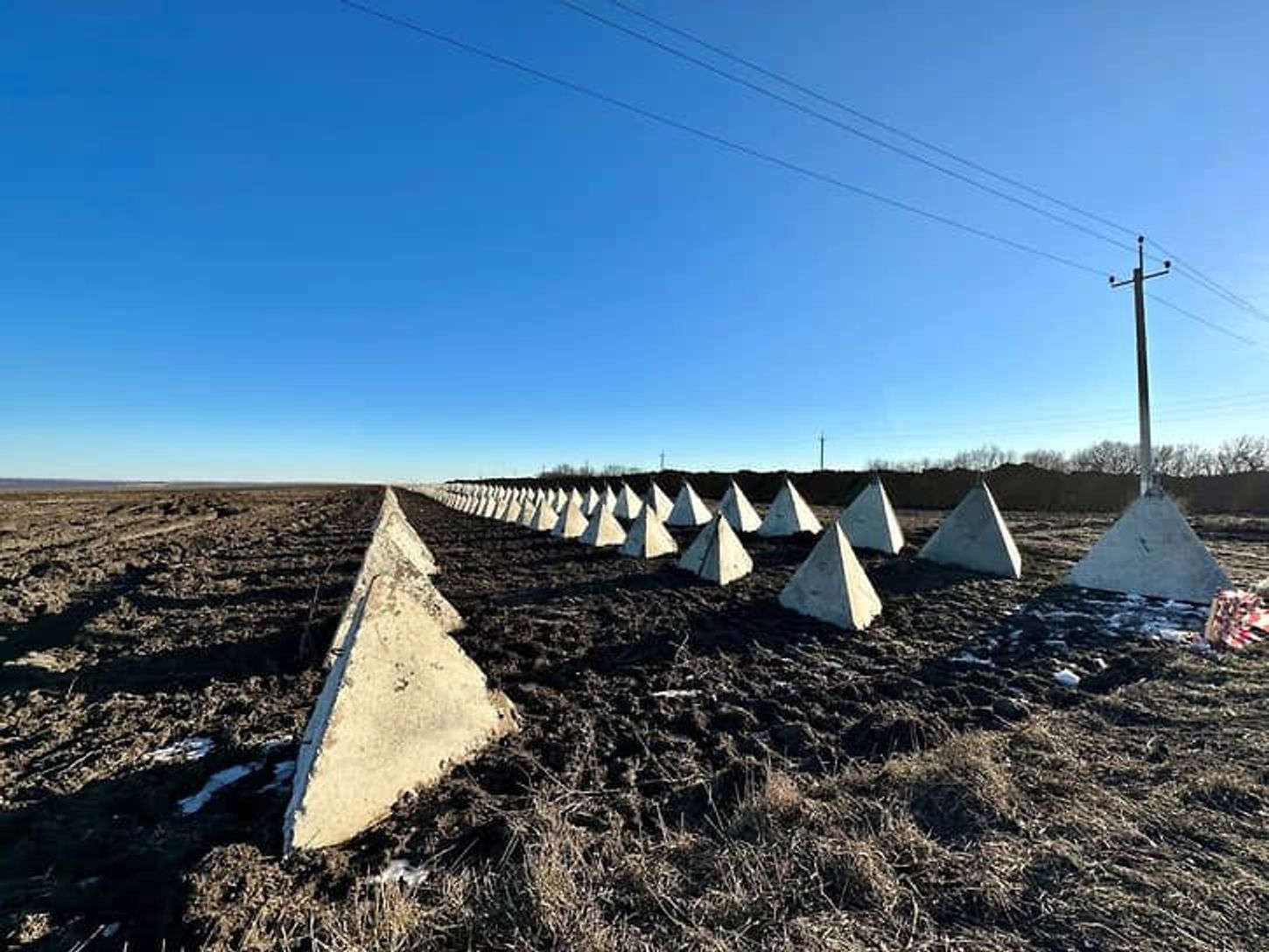
Battles in the region were still raging as of 6:00 p.m. Moscow time. Rybar noted that the saboteurs were able to consolidate near Kozinka and remain on the outskirts of Grayvoron. According to the channel, shelling of the entire border area of the Belgorod region, including the military facility known as Belgorod-22, is ongoing. “The accumulation of AFU manpower on the other side of the border has been known for a long time – but no one has drawn conclusions,” Rybar wrote.
“Object 1150” (also known as Belgorod-22) is close to Grayvoron, located on the territory of military base 25624, which is under the jurisdiction of the 12th Main Directorate of the Russian Defense Ministry, responsible for storage of tactical nuclear ammunition. Rybar claimed that nuclear weapons have long been absent there, but Ukrainian military intelligence spokesman Andriy Yusov said that the Russians were urgently removing nuclear warheads from the area.

Mikhail Podolyak, an adviser to the head of the Ukrainian Presidential Office, tweeted that the attacks were carried out by Russian partisans opposing the totalitarian Putin regime. “As you know, you can buy tanks in any military store, and the partisan groups consist exclusively of Russian citizens,” Podolyak said. In 2014, Vladimir Putin referred to the Russian military who seized Crimea as “local self-defense forces,” and the military uniforms, in his opinion, could have been bought “in a store.”
Losses
At the G7 summit in Japan, US President Joe Biden claimed that Russian forces had lost 100,000 people (the figure evidently includes killed and wounded) during the operation to seize Bakhmut. The US National Security Council Coordinator for Strategic Communications, John Kirby, had earlier cited a total figure of 100,000 Russians killed and wounded since the beginning of the year, half of which were reported in Bakhmut. Biden also misinterpreted the estimate, as did some media outlets. Notably, even the Ukrainian estimate of 70,000 Russian casualties killed and wounded in the fighting for Bakhmut, recently announced by Defense Minister Oleksii Reznikov, is lower than the estimate given by Biden.
A video appeal to Vladimir Putin by the relatives of mobilized soldiers from Khakassia, as well as the Altai and Kemerovo regions, which has been widely circulated on social media, can help assess whether the claimed losses are true. It shows that out of 501 servicemen who were sent on combat missions, only 130 returned. If the claims of the soldiers’ relatives are to be believed, the mobilized men were “bought out” by the 60th Separate Sabotage and Assault Brigade “Veterany” for 25,000 roubles ($310) “per head.” Reports had previously confirmed the presence of “Veterany” in the Bakhmut direction – a Telegram post from Daniil Bezsonov, an official of the so-called “DPR,” described them taking part in combat.
Fox News reported on the total losses sustained by both Ukraine and Russia, citing unnamed officials in the Biden administration. According to Fox News’ data, the Ukrainian side has lost 20,000 killed and 130,000 wounded, while the Russian side has lost 50,000 killed and 180,000 wounded. It also states that some 42,000 civilians were killed.
The striking difference in the killed-to-wounded ratio is of particular note: 1:6.5 for the AFU against 1:3.6 for the Russian forces (in comparison, the ratio for the Red Army in the Berlin operation was 1:3.5, and 1:8.5 for the US during the war in Afghanistan). The difference can be explained by the deplorable state of Russian tactical medicine, which was discussed in more detail in the “Losses” section of our previous summary.
A number of Ukrainian sources reported that an Su-35 fighter jet was shot down over the Black Sea. Fighterbomber, a Telegram channel linked to the Russian Air Force, hinted that an S-300 SAM system deployed south of Odesa was involved in the incident. According to the channel's administrator, the coordinates of the location of the complex were sent to him by “subscribers from Ukraine” two days before the downing of the Russian plane, after which they were sent “to the right place.” He speculates that it would have been better if they had just been posted on the channel, since the information goes through many “chains, command reports, explanatory notes, and signatures in logs” at the Defense Ministry. As a result, the Ukrainian air defense complex “went away whole and unharmed for its state awards.”

Arms supplies
Details surrounding the transfer of F-16 fighter jets to Ukraine are gradually becoming clearer. According to Ukrainian Air Force spokesman Yuriy Ihnat, the country’s Western allies will initially transfer 12 to 18 fighters to Kyiv.
The European Union’s head dipolmat Josep Borrell announced that Ukrainian pilots had already begun training on F-16 fighters. He welcomed the decision to transfer the fighters to Ukraine, and added that the Ukrainian Armed Forces had a great need for them. At the same time, no confirmation was received from representatives of European countries, which declared their support for the “fighter coalition,” about the start of training.
Italy has secretly transferred a batch of B1 Centauro “wheeled tank destroyers” armed with 105 mm/52 caliber Oto Melara guns to Ukraine, according to a report from an Italian military analyst with the A-129 Mangusta nickname on Twitter. The combat vehicles were spotted at Caserta railway station along with old Iveco LMV armored vehicles not used by the Italian army, which have been previously supplied to Ukraine. The B1 Centauro resembles the French AMX-10RC armored reconnaissance vehicle (both are often incorrectly called “wheeled tanks”) already delivered to Ukraine, but differs favorably from the latter in gun stability, which allows it to fire on the move. Another of the Centauro’s advantages is its fire control system, which is also installed on Italian C1 Ariete tanks.
The US has announced a new $375 million military aid package for Ukraine, which will be allocated under President Biden’s administrative authority from the US Department of Defense's holdings. The new package includes GMLRS missiles for the HIMARS system, 155mm and 105mm artillery rounds, laser guided missiles, Javelin anti-tank missile systems and AT4 grenade launchers, armored bridging systems, medical armored vehicles, trucks and trailers to transport heavy equipment, demolition munitions, thermal imagers, spare parts, and other field equipment.